These lemon curd meringue cookies have a crunchy outer shell, a soft, melt-in-your-mouth center, and are covered with a silky lemon curd. Meringue is a labor of love, but once you get it right, they are so worth it. There is something so special about the way meringue forms a crispy shell and soft inner center that makes them *mwah* chef's kiss!
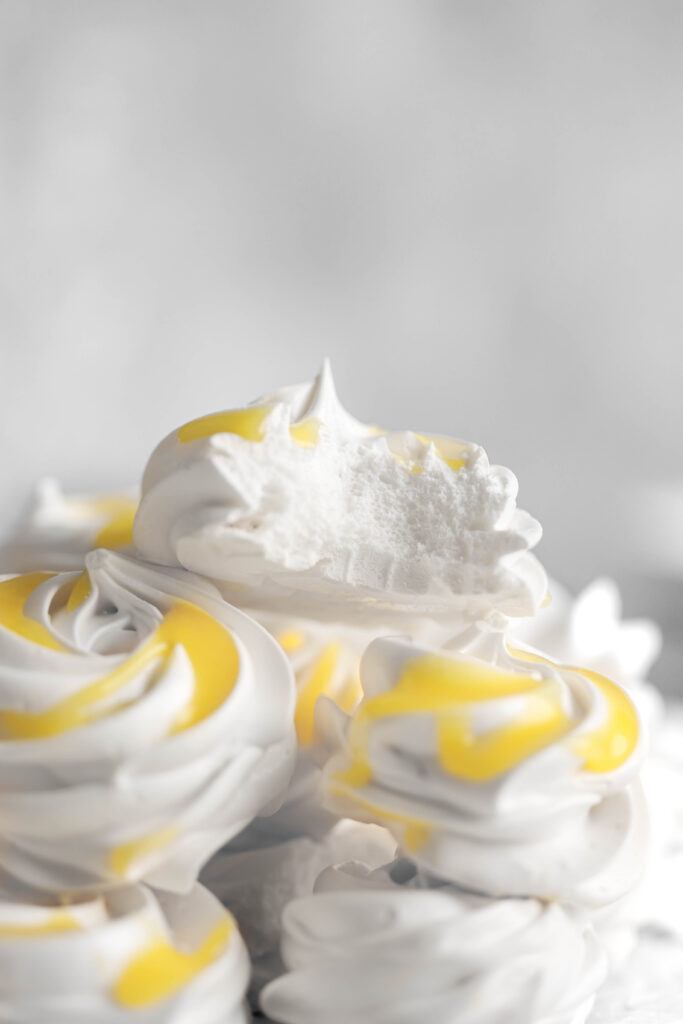
What is meringue?
In its most basic form, meringue is whipped egg whites and sugar. There are a few different methods to make meringue. The sugar is either added slowly to whipping egg whites (french) or all at once and heated (swiss).
Swiss is my preferred method, and what we do here. There is also Italian - which is made by combining sugar and a liquid and boiling them until it hits the point of "candy" on a candy thermometer, then slowly adding this to whipping egg whites.
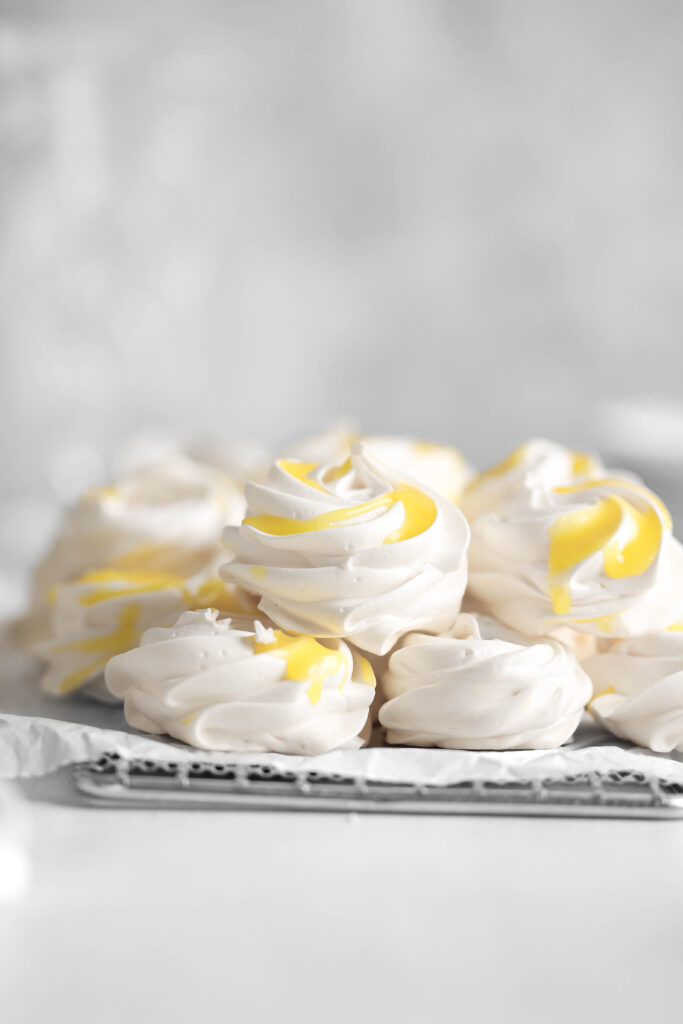
What is the Swiss method?
The swiss method combines sugar and egg whites over a boiling water bath and slowly heats them together until the sugar granules are dissolved. You should be able to pinch the liquid and not feel any of the sugar granules in between your fingers. This then gets whipped at high speed for a soft, silky, pillowy meringue.
I find this to be the method that has the least room for error. With the french method, you run the risk of dumping in too much sugar at once and deflating the air in the whipped egg whites. With the italian method, you run the risk of not boiling the mixture until the point of "candy." So I find this method to be the safest.
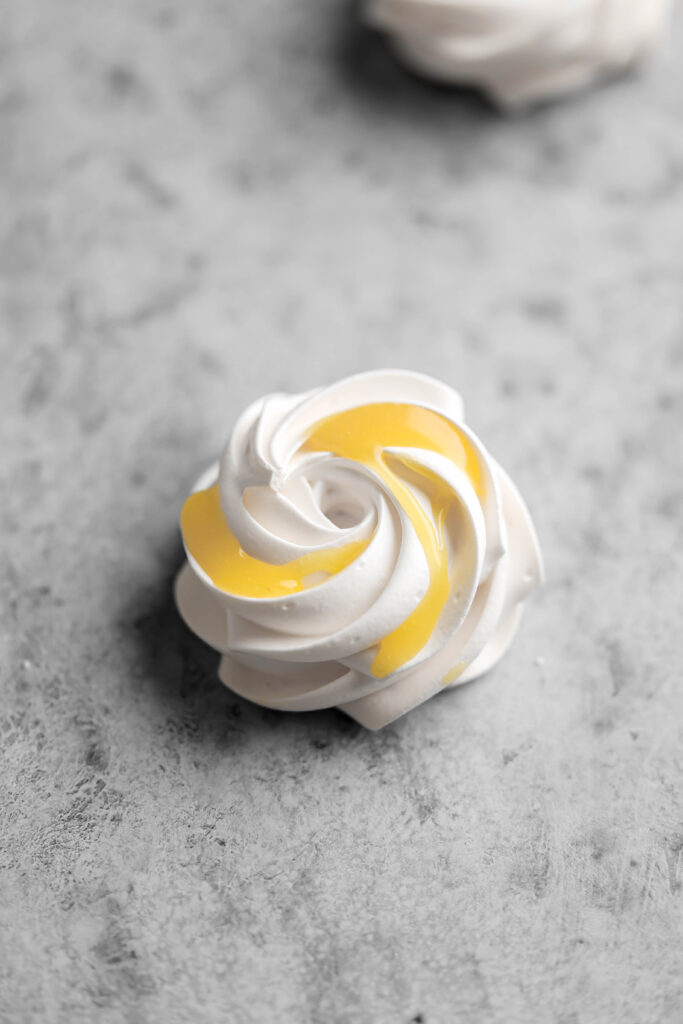
Why you will love these lemon curd meringue cookies
- The lemon curd. Lemon plus meringue is a very popular flavor combo. If you haven't tried it, my Lemon Meringue Cupcakes are a great place to start. BUT ANYWAY, the lemon curd is so easy to make, is super lemony, and I like to add in an extra step where we strain it to get rid of all the lemon zest so the texture is super smooth.
- Minimal ingredients. While meringue itself may be a labor of love (meaning a lot of things can go wrong), the ingredients could not be simpler! Just egg whites, sugar, vanilla extract, and cream of tartar.
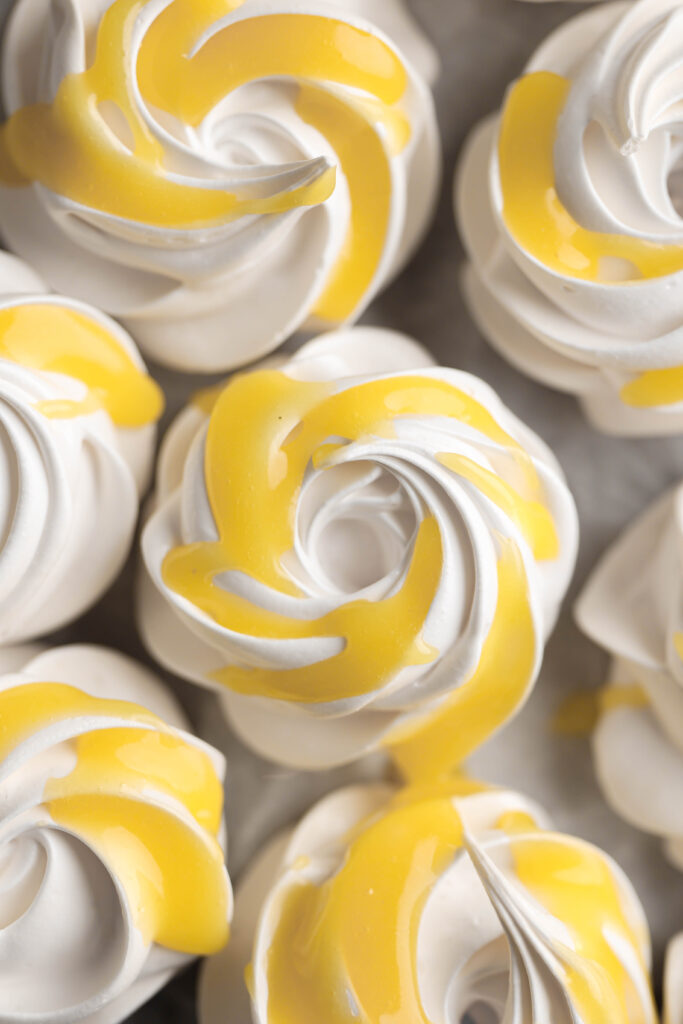
Key ingredients
- Eggs: eggs are pretty much the main ingredient in both meringue and lemon curd. We separate the whites from the egg yolks - the whites go to the meringue and the yolks go to lemon curd.
- Granulated sugar: granulated sugar is the sweetener in both the meringue and lemon curd.
- Cream of tartar: cream of tartar is a key ingredient in the meringue - it stabilizes the egg whites and helps provide those characteristic stiff peaks in meringue.
- Lemons: we'll need about two-three large lemons for the lemon juice/zest that is used in the curd.
- Unsalted butter: unsalted butter is added to the hot curd to thicken the mixture and provide flavor/richness.
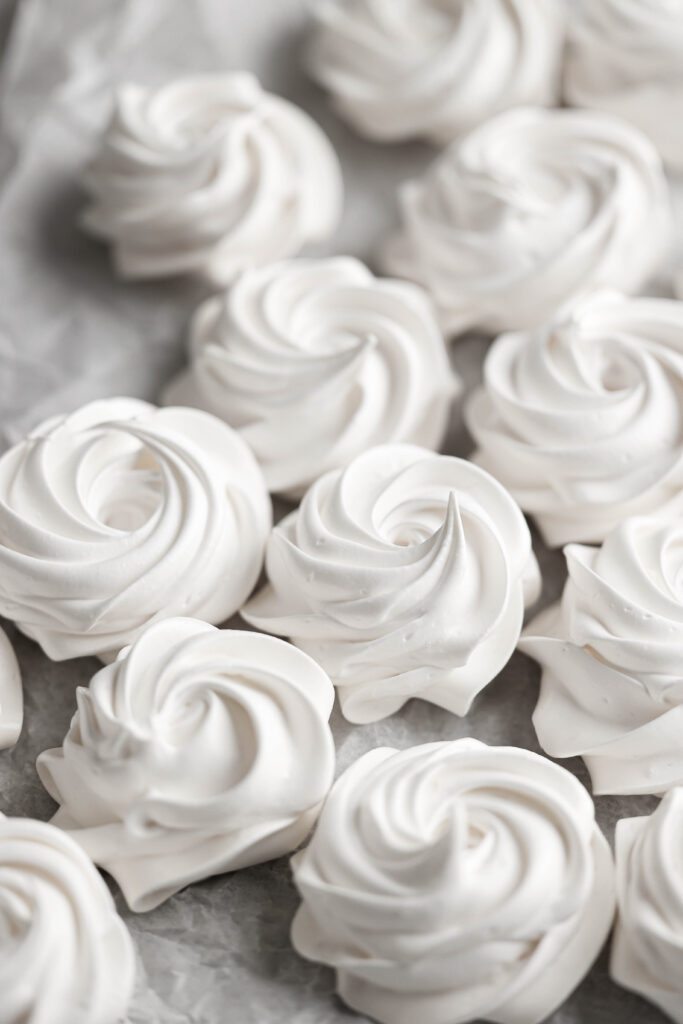
How to make meringue
Heat the meringue using the swiss method
- Combine the ingredients. In a heat proof bowl, combine the egg whites, sugar, vanilla, and cream of tartar.
- Heat the mixture. Place the bowl over a pot that has 2 inches of boiling water, but make sure the water does not touch the bottom of the bowl.
- Whisk. Whisk the mixture together over a water bath. In this step, you are heating up the mixture until it gets to about 160F. This pasteurizes the egg whites and makes them safe to eat. It also aids in the dissolving of the sugar into the egg whites.
- Pinch the mixture. The mixture will start out thick but will thin out after it heats up. Once it's thinner and frothy on top, use your whisk/spatula to pick up some of the mixture and let it drop in between your fingers. If you pinch it together, you shouldn't be able to feel any of the sugar granules.
- Whip the mixture. Once it has been 4-5 minutes and the sugar granules cannot be detected, remove from the heat and pour the mixture into the bowl of a stand fixer fitted with the whisk attachment. Beat on high speed for 4-6 minutes until thick and glossy, stiff peaks are formed. You should be able to turn the bowl completely upside down and none of the meringue will fall out.

Baking and cooling the meringue
- Pipe. Pipe the meringue onto a baking sheet using a piping bag with a star tip - you can space them pretty close together as they will not spread.
- Bake. Bake them for at least one hour. All ovens differ, elevations differ, humidity differs, the size of your meringue differs, etc., so I cannot say how long it will actually take to bake. You should be able to gently lift the meringues off of the pan. If you tap the bottom of the meringue, it should sound hollow.
- Leave to cool. Once the meringues are done, turn the oven off and leave them in the oven for one hour with the door shut. Then, leave them in the oven for an additional one hour with the door cracked. After that hour is up, you can remove them from the oven.

Meringue making tips
- Wipe down your mixing bowl. Any fat residue on the mixing bowl can prevent stiff peaks from forming.
- Whip to just stiff peaks. You do not want to over-whip as this can cause cracking or seeping.
- Bake the meringue immediately. If you leave the meringue out for a while before baking, it will stiffen.
- Don't rush the cooling process. If you rush the cooling process, the meringues can crack. Let the meringues cool in the oven for one hour with the door closed, then for another hour with the door cracked (both while the oven is off).
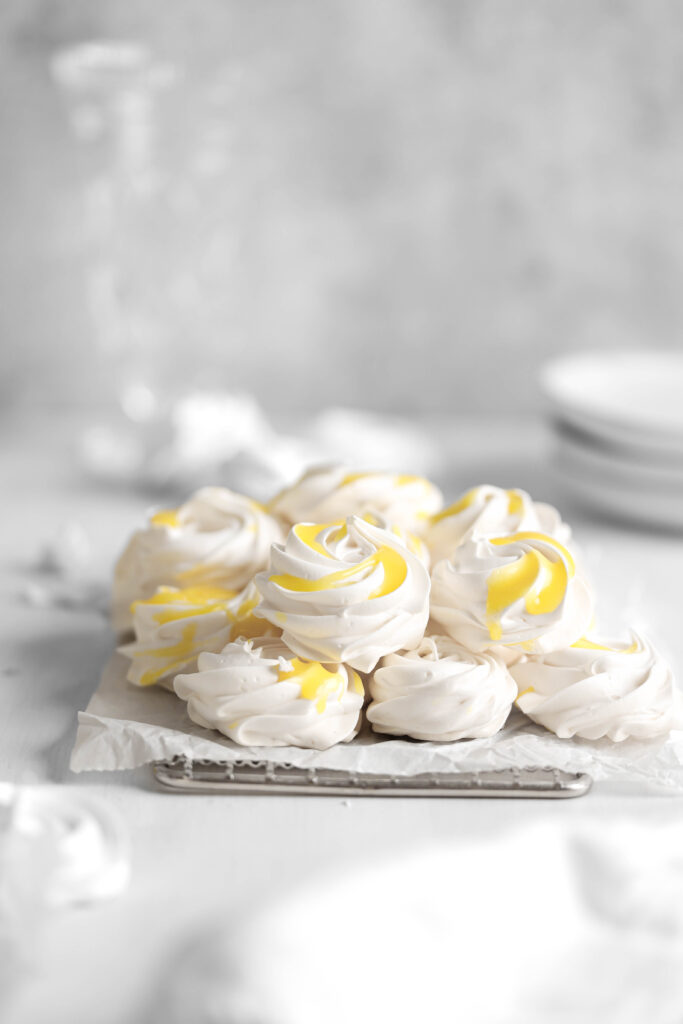
How to make lemon curd
- Combine the ingredients. In a medium-sized pan, whisk together the egg yolks, sugar, lemon zest, and lemon juice.
- Heat the mixture. Heat the mixture over low-medium heat until it begins to simmer and thicken. It should be about 160F if you have a thermometer.
- Add the butter. Remove from the heat and immediately add the butter. Whisk until the butter has completely melted into the curd.
- Strain. Strain the mixture and discard the lemon zest.
- Let cool. Let the mixture cool in a wide bowl and cover it with a piece of plastic wrap placed directly on top of the curd. This will prevent a film from forming.
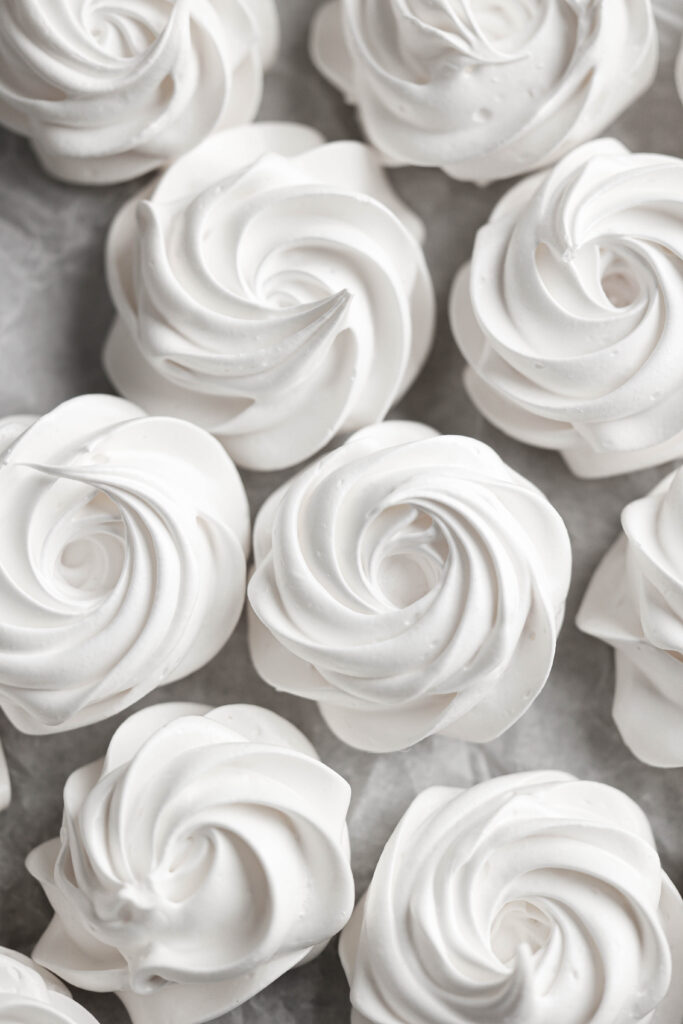
FAQ
What are stiff peaks?
'Stiff peaks' is a term used with meringue that defines how much a meringue has been whipped. When your meringue has hit stiff peaks, it means that the meringue is glossy, thick, and the tips can stand up without curling over. If you pick up the whisk attachment directly out of the meringue, the tip should stand perfectly straight and not droop over. It helps to check often so that you don't over-whip the meringue.
Why did my meringues crack?
If the baked meringue cracks, it's likely that it was over-whipped or baked at too high of a temperature too quickly (this can happen with ovens that run hot). This can also happen from a sudden change in temperature - that is why we leave the meringues in the oven to cool for two hours.
Why did my meringues seep liquid?
If the meringues seep any liquid while they are baking or cooling, is is likely that the meringue was either over-whipped or underbaked.

How come my meringues are yellow?
Yellowing happens when the meringues are baked too long or at too high of a temperature.
Why did my meringue not form stiff peaks?
Did any of the egg yolk get added to the mixture? Did you wipe your bowl with vinegar first? If any fat gets into the mixture, there is the possibility that it won't whip up to stiff peaks.
Why are my meringues soft?
If you baked the meringues to what you thought was completion, but then they went all soft, they need to be baked longer. This can also be from general kitchen humidity - but this is something we cannot control.
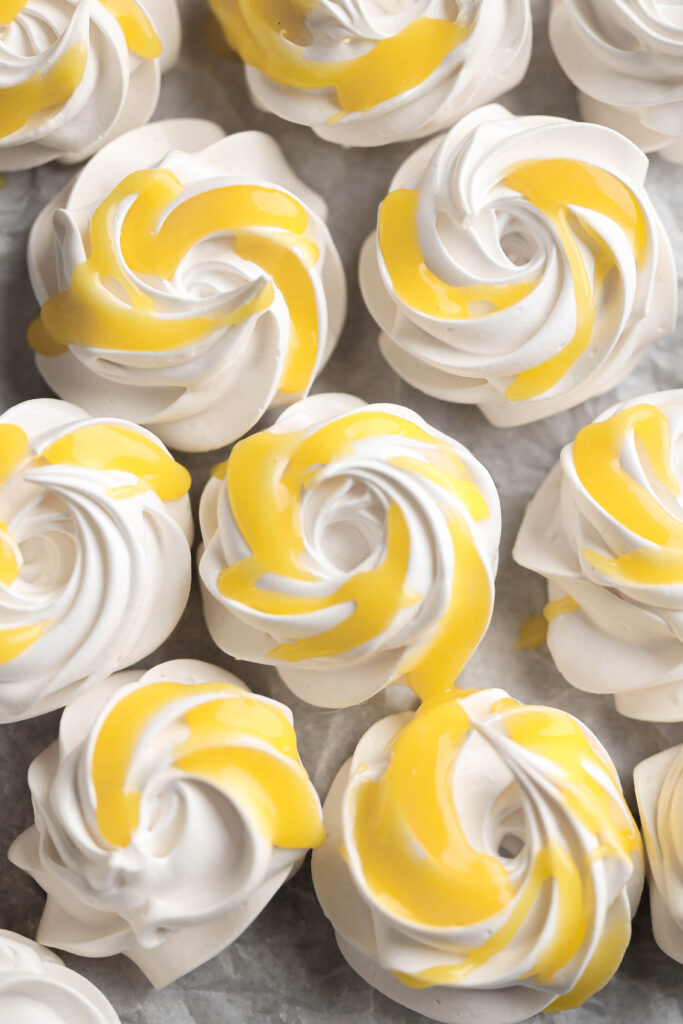
Baking in grams
While I provide volume measurements for the recipes on my blog, I highly suggest baking these recipes using weight. It is the most standardized and accurate way to bake. I carefully recipe test all of my recipes using a kitchen scale, not by using cups, and therefore I cannot guarantee the success of my recipes when using volume measurements.
Other meringue recipes you may like
- Classic Key Lime Pie With Meringue
- Pumpkin Pie With Meringue
- S'mores Chocolate Mousse Ice Box Cake
- Lemon Meringue Cupcakes
- Fluffernutter Cupcakes
This post may contain affiliate links.
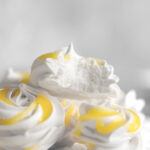
Lemon Curd Meringue Cookies
Equipment
Ingredients
Meringue
- 4 egg whites
- 1 cup (200 grams) granulated sugar
- ½ teaspoon cream of tartar
- ½ teaspoon vanilla extract
Lemon Curd
- ½ cup (100 grams) granulated sugar
- 3 egg yolks
- 3 tablespoons lemon zest about 2 large lemons
- ¼ cup (60 grams) fresh lemon juice about 2-3 large lemons
- ¼ cup (57 grams) unsalted butter cold and cubed
Instructions
Meringue
- Wipe down your mixing bowl with vinegar.
- Preheat oven to 225F and line a baking sheet with parchment paper. Set aside. Prepare a piping bag with a star tip. Set aside.
- Fill a sauce pan with about two inches of water and bring it to a gentle simmer. Separate the yolks from the egg whites and make sure NONE of the yolk gets into your egg white mixture. This could mess up the entire batch. Any fat will prevent stiff peaks from forming. Save the yolks for the lemon curd.
- In a heat proof bowl, place the egg whites, sugar, cream of tartar and vanilla extract. Place the bowl on the sauce pan over the simmering water but do NOT let the bottom of the bowl touch the simmering water.
- Continuously whisk while the mixture heats up. It will start out thick but will thin out as you keep on whisking. Switch to a rubber spatula and use that to mix (while also scraping the sides of the bowl) for about 4-5 minutes until the mixture is thin and frothy on top - if you have a thermometer, it should be around 160 degrees Fahrenheit.
- Use your whisk to pick up some of the mixture and let it drop in between your fingers. If you pinch it together, you shouldn't be able to feel any of the sugar granules.
- Remove from the heat. Using a handheld mixer or in the bowl of a stand mixer fitted with the whisk attachment, beat the mixture on high speed for 5-6 minutes until glossy, thick, stiff peaks form. You should be able to turn the bowl completely upside down and none of the meringue will fall out.
- Fill your piping bag with the meringue. Pipe cookies onto the baking sheet in any shape you want, although size here is important. Try your best (if you can use a scale, do it) to make each cookie the same size. This is important when it comes to the baking time - you want all cookies to be the same size so that they all cook evenly and fully. See note if you do not have piping materials.
- Bake for ABOUT an hour. It could be more - all ovens differ, elevations differ, humidity differs, the size of your meringue differs, etc., so I cannot say how long it will actually take to bake, but you should look for these clues: One. You should be able to gently lift the cookie off of the parchment paper. Two. If you tap the bottom of the cookies with your finger, it should sound hollow. Three. It should also be dry to the touch.
- Turn the oven off but leave the cookies on the pan in the oven for one hour with the door shut.
- After the hour, crack the oven door open and let them sit in the oven with the door cracked for another hour. This will help to make sure the meringues do not crack.
Lemon Curd
- While the meringues are baking, make the lemon curd. In a medium sauce pan, combine the granulated sugar and egg yolks. Whisk them together until smooth and combined. Add the lemon zest and lemon juice and whisk until combined.
- Place the pan over the stove on low-medium heat and stir constantly while it heats up. The mixture will begin to thicken and bubble. Once it begins to bubble, it should be done. If you have a thermometer, it should be about 160 degrees Fahrenheit.
- Remove from the heat and add the cubed butter. Stir until the butter has completely melted and the mixture is combined.
- Strain the lemon curd into a bowl and get rid of the lemon zest. Cover it with cling wrap/tin foil that is placed directly onto the curd. This will prevent a film on the top of the lemon curd from forming. Let it cool at room temperature while the meringues bake/cool.
- Once the meringues are cool, spoon the lemon curd onto the cookies and enjoy! Store in a container that is completely airtight at room temperature.
Notes
- If you do not have any piping materials, you can also use a spoon to just scoop the mixture and plop it on the baking sheet. But again, try to make sure they are similar in size. Use a measuring cup if you can.
Tried this recipe? Make sure to rate and review and tag @sturbridgebakery on Instagram!


Leave a Reply